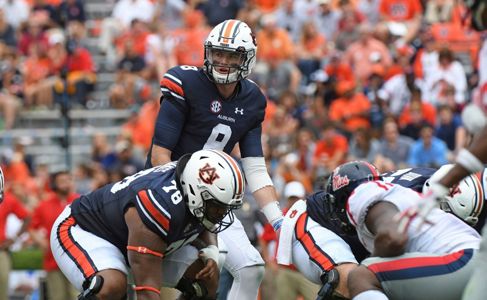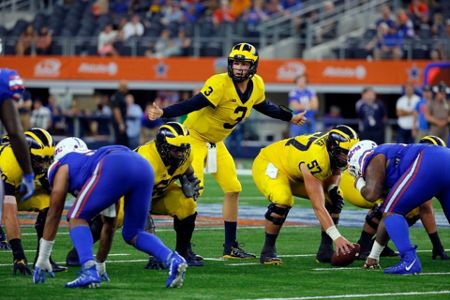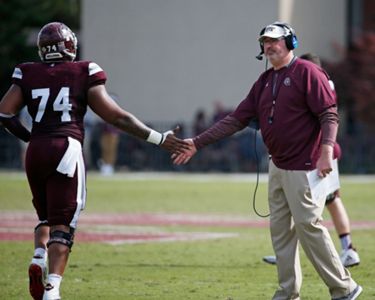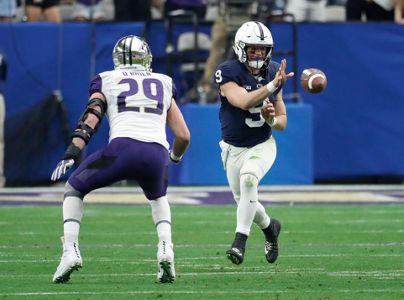The result of the play is a first down and the offense rushes to the line of scrimmage and sets up, linemen in their three-point stances, receivers out wide. The quarterback directs traffic, barks out something or other, maybe claps his hands, and then ... he stops and looks to the sideline for a play to be signaled.
Hurry-up offense? More like hurry-up-and-wait.
The fast-paced, no-huddle offenses made fashionable by Chip Kelly, Rich Rodriguez and most of the Big 12, fueling a scoring frenzy in college football for more than a decade, are becoming less prevalent.
Last season scoring was down in college football, a drop of about a point and a half per game per team to 28.8, and the lowest mark since 2011 (28.3). But a deeper look into the numbers shows that defensive coordinators don't have much to celebrate. Offenses are still performing at a high level. They were, generally, just operating more slowly in 2017. And there is reason to believe this is the new normal as the allure of playing fast dissipates.
"I think that what's happened is you have a group of us that are playing ultra-fast and some people that tried to get into it that really don't understand it, they're playing slower," Oklahoma State coach Mike Gundy said this spring.
FBS teams averaged 69.9 plays per game in 2017, down from 71.6 the season before and the fewest since 2011. Eighty-three of 129 FBS teams last season ran fewer plays per game than in 2016. Seven teams averaged at least 80 plays per game last year, half as many as in 2016 and the fewest since 2011. There were 31 teams that ran fewer plays per game last season than in 2016, but saw their average time of possession increase.
Championship Analytics Inc., a company that provides dozens of FBS schools a weekly advanced metrics breakdown of their upcoming game, uses drives per game to measure pace. Responding to a request from The Associated Press, CAI's research showed drives per game have been decreasing in FBS for the last three seasons. In 2014, FBS games averaged 25.12 drives per game. Last season that dropped to 24.39. Points per drive, however, have remained relatively steady. In 2014, teams averaged 2.21 points per drive. Last season, it was 2.23.
Multi-tempo has replaced up-tempo for a lot of college offenses. Mississippi State's Joe Moorhead, who was offensive coordinator at Penn State the last two seasons, said his offense mostly operates at three speeds.
"We want to run the best play possible against the look presented rather than a bad play quickly," said Moorhead, repeating one of his go-to lines when describing his offensive philosophy. "But at the same time have the ability that if we're getting the right looks and calling the right plays to play at that break-neck speed."
This is the hurry-up-and-wait approach. By rushing to the line of scrimmage and making no substitutions, offenses get the benefit of forcing defenses to stick with the personel they have on the field.
"They're getting lined up really fast so they have plenty of time left on the 40-second clock to see what you're doing defensively," said Pittsburgh coach Pat Narduzzi, a former defensive coordinator. "They all want perfect plays."
Mississippi State defensive coordinator Bob Shoop said he believes offenses are looking for more than just formations.
"I think the game has changed from going as fast as you can to lining up as fast as you can and trying to steal the defense's signals," Shoop said. "I think that's what you see a lot of teams doing nowadays. Trying to get the defensive coordinator, the defensive signal caller's signals, and get into the right play in that respect."
Offensive coaches will tell you that signal stealing can go both ways, and other defensive adjustments have pushed them to throttle back.
When Oregon's offense was humming under Kelly, defenses struggled to simply get lined up. The Ducks would run the same basic running play three straight times against defensive linemen who barely had time to get into a stance.
The speed alone killed.
"I think defensive coaches have adjusted how they practice," Troy coach Neal Brown said. "Some people use two scout teams and run multiple plays in a row. Even non-tempo teams play with tempo during the spring and fall camp to help the defense practice."
Players who can fill multiple positions are now the norm for defenses, allowing coordinators to change formations without changing personnel — because defense can only substitute if the offense does. Every coach is looking for versatile players like Minkah Fitzpatrick and Jabrill Peppers, first-round NFL draft picks the last two years, who can comfortably move from cornerback to safety to linebacker to edge pass rusher.
Defensive coaches as getting their plays in faster, using one- or two-word calls, and building automatic checks into those calls for when the offense changes formations at the line.
Defenses are also better at gamesmanship. Sure, teams will still fake injuries to get a rest for winded defenders, but there are less shady ways to tap the brakes, too.
If the offense makes a substitution, even if it is one receiver for another and the personnel grouping remains the same, defenses often counter with an automatic sub of a lineman, preferably one far away from his sideline.
"The defense is not responsible for sprinting onto the field," Shoop said. "I know the last couple years, where we just substituted a random defensive tackle or defensive end into the game just to slow the pace of play down. And in addition we've actually worked on and coached that player on the pace that we want him to run on the field."
Another factor could be playing a part in the slowdown. NCAA coordinator of officials Steve Shaw said there was a point of emphasis nationally last season to have officials be more consistent in spotting the ball and, after a clock stoppage on an out-of-bounds play, winding the clock. The idea was to be more conscious of game management, making sure officials and yard-markers on the sideline were set, before letting the offense snap. Shaw said the goal was more consistency across the country in how that mechanic was performed.
"Did that shave a second off here or there or not?" Shaw said. "Hard to tell."
For what it's worth, Shaw said he was not besieged by complaints from coaches about officials slowing their offenses, so that's a good sign.
Where does this go from here?
Keep an eye on Kelly's new team, UCLA, for clues. Kelly has never been one to tip his hand, but if one of the up-tempo pioneers decides to ease off the gas, that'd be a strong sign that the fast-football craze is officially over.
___
Follow Ralph D. Russo at www.Twitter.com/ralphDrussoAP and listen at https://www.podcastone.com/AP-Top-25-College-Football-Podcast
___
More AP college football: https://apnews.com/tag/Collegefootball and https://twitter.com/AP_Top25
Copyright 2018 The Associated Press. All rights reserved. This material may not be published, broadcast, rewritten or redistributed.







